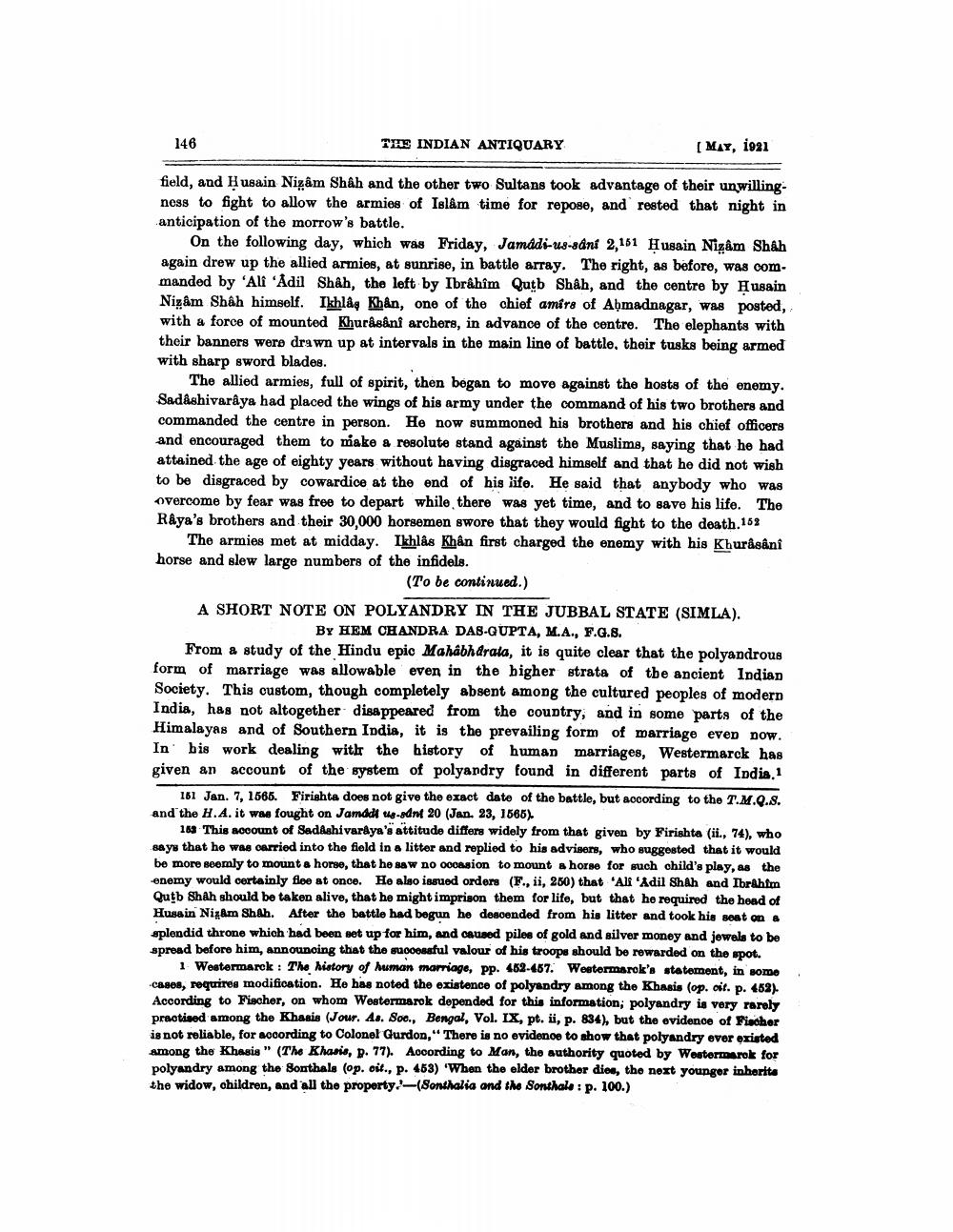________________
146
THE INDIAN ANTIQUARY
[ MAY, 1921
field, and Husain Nizam Shah and the other two Sultans took advantage of their unwillingness to fight to allow the armies of Islam time for repose, and rested that night in anticipation of the morrow's battle.
On the following day, which was Friday, Jamadi-23-8ání 2,151 Husain Nizam Shah again drew up the allied armies, at sunrise, in battle array. The right, as before, was commanded by 'Ali `Adil Shah, the left by Ibrâhîm Qutb Shah, and the centre by Husain Nizâm Shâh himself. Ikhlag Khan, one of the chief amirs of Abmadnagar, was posted, with a force of mounted Khurasani archers, in advance of the centre. The elephants with their banners were drawn up at intervals in the main line of battle, their tusks being armed with sharp sword blades.
The allied armies, full of spirit, then began to move against the hosts of the enemy. Sadashivarâya had placed the wings of his army under the command of his two brothers and commanded the centre in person. He now summoned his brothers and his chief officers and encouraged them to make a resolute stand against the Muslims, saying that he had attained the age of eighty years without having disgraced himself and that he did not wish to be disgraced by cowardice at the end of his life. He said that anybody who was overcome by fear was free to depart while there was yet time, and to save his life. The R&ya's brothers and their 30,000 horsemen swore that they would fight to the death.163
The armies met at midday. Ikhlâs Khân first charged the enemy with his Khurâsânî horse and slew large numbers of the infidels.
(To be continued.) A SHORT NOTE ON POLYANDRY IN THE JUBBAL STATE (SIMLA).
BY HEM CHANDRA DAS-GUPTA, M.A., F.G.8. From a study of the Hindu epio Mahabharata, it is quite clear that the polyandrous form of marriage was allowable even in the higher strata of the ancient Indian Society. This custom, though completely absent among the cultured peoples of modern India, has not altogether disappeared from the country, and in some parts of the Himalayas and of Southern India, it is the prevailing form of marriage even now. In his work dealing with the history of human marriages, Westermarck has given an account of the system of polyandry found in different parts of India. 1
161 Jan. 7, 1566. Firishta does not give the exact date of the battle, but according to the T.M.Q.8. and the H.A. it was fought on Jamddt t-sdn 20 (Jan. 23, 1566).
183 This account of Sadashivargya's attitude differs widely from that given by Firishta (ii., 74), who says that he was carried into the field in a litter and replied to his advisers, who suggested that it would be more seemly to mount a horse, that he saw no occasion to mount a horse for such child's play, as the enemy would certainly floe at once. Ho alao issued orders (F., ii, 250) that 'All 'Adil Shah and IbrAhim Qutb Shah should be taken alive, that he might imprison them for life, but that he required the head of Husain Nizam Shah. After the battle had begun he descended from his litter and took his seat on a splendid throne which had been set up for him, and caused piles of gold and silver money and jewels to be spread before him, announcing that the successful valour of his troops should be rewarded on the spot.
1 Westermarck : The history of human marriage, pp. 452-487. Westermarok's statement, in some C8908, requires modification. He has noted the existence of polyandry among the Khasis (op. oit. p. 452) According to Fischer, on whom Westermarok depended for this information, polyandry is very rarely practised among the Khasis (Jour. As. Soo., Bengal, Vol. IX, pt. ii, p. 834), but the evidence of Fischer is not reliable, for according to Colonel Gurdon," There is no evideno to show that polyandry ever existed among the Khasis" (The Khasis, D. 77). According to Man, the authority quoted by Westermarok for polyandry among the Sonthals (op. cit., p. 453) 'When the elder brother dies, the next younger inherita the widow, children, and all the property.-(Sonthalia and the Sonthale : p. 100.)




